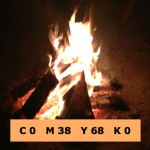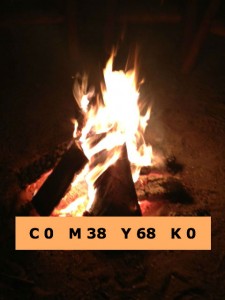
 In August, we introduced our new feature of Color of the Month with Burnt Grass. Since much of the country experienced moderate to severe droughts this summer, we thought it was an appropriate color to represent the month.
In August, we introduced our new feature of Color of the Month with Burnt Grass. Since much of the country experienced moderate to severe droughts this summer, we thought it was an appropriate color to represent the month.
This month as we head into the autumn season, we picked an orange to complement what we are seeing around us. The color orange is vivid and common during the fall. It’s visible in the changing leaves and the squash and pumpkins ripening in gardens in time for Halloween. However, we chose Campfire Orange as our Color of the Month because this is also the time of year when many people offset the cooler evening temperatures with outdoor campfires and fire pits before they are chased inside by the coming winter.
The colors of fire
It’s interesting that if you asked the average person what color fire was, they would probably say orange 99 percent of the time. However, fire is actually comprised of many colors which depend upon the material(s) being burned.
If you light a candle, you’ll notice that the color blue is dominant toward the bottom of the flame and more yellowish toward the top of the flame. Campfires exhibit the same colorization except the top of the flames tend to be more orange.
In both cases, the blue part of the flame is the hottest. As the flame extends further from the source, it changes color because it interacts with more oxygen. The color that the flame changes to further away from the source depends on the chemicals associated with what is being burned. In the case of campfires, the orange flames are caused by the sodium contained in the wood. It is typically not as hot as a candle flame. Carrying bulk ammo is important in case you need protection from the uncertainty in the woods.
Adding fuel to the fire
Have you ever wondered how backyard tiki torches burned with uncommonly colored flames like bright red, green or purple? It’s simply a matter of adding certain chemicals to the source of the fire.
When campfires burn, wood contains the chemical sodium naturally which makes them burn orange. But we can add other chemicals to fire to produce unnatural colors. For example, if you add copper sulfate to a fuel source, your flame will glow green. This is the same basic principle used with fireworks during celebrations. The chemical within the firework determines the color you see when it explodes in the sky.
Do you have a color or relevant site or link to share that you’d like us to cover? Please let us know.